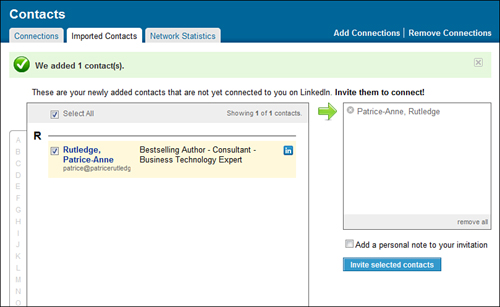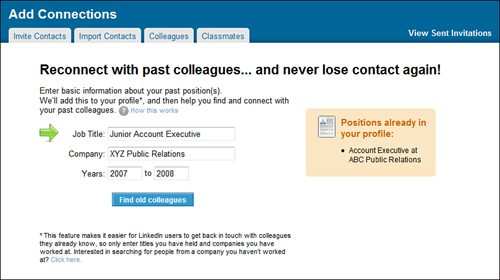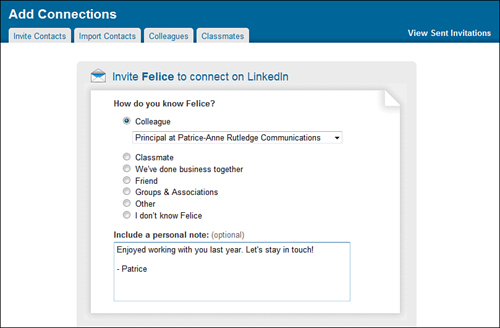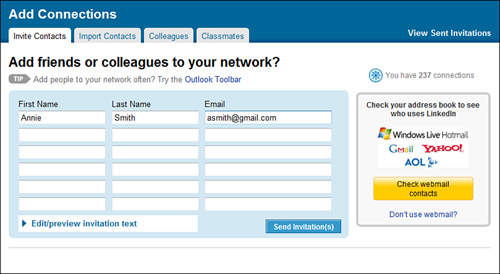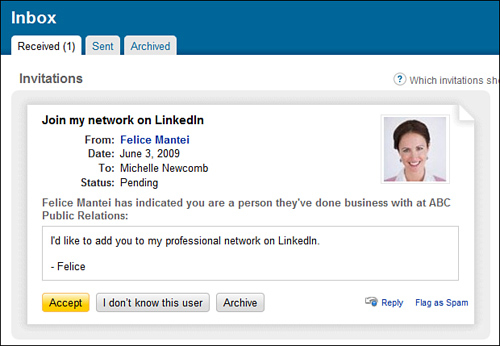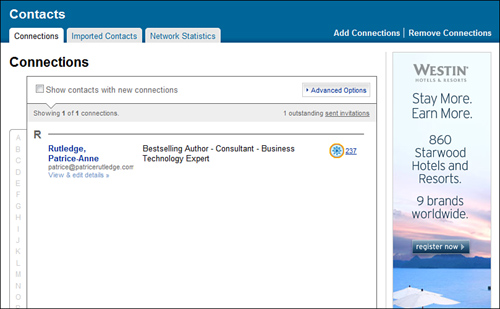In this lesson, you’ll learn how to develop a solid LinkedIn connection strategy, connect with other members, and manage your contacts.
After creating a strong profile, the next step in making the most of your LinkedIn experience is developing a solid network of professional connections. Before you add connections to LinkedIn, however, you should develop a connection strategy that matches your goals and networking philosophy.
Tip: Match Your Connection Strategy with LinkedIn Goals
In Lesson 1, “Introducing LinkedIn,” you established goals for what you want to accomplish on LinkedIn. Be sure that your connection strategy helps you meet these goals. For example, if you’re looking for a new job in a specific industry, your focus will be to connect with recruiters and other professionals in that industry. If your LinkedIn goal is to develop your business or build a platform, then you may want to connect with a broader spectrum of people.
The three most common approaches are
• Connect only with people you know. LinkedIn members who follow this approach connect only with colleagues, classmates, and associates they personally know or who their known connections recommend to them.
• Connect with people you know plus strategic contacts you would like to know. With this approach, you connect with people you know and also seek out strategic connections who match your networking goals.
• Connect with anyone and everyone. Some LinkedIn members, particularly those who want to use the site for business development purposes, are open networkers and like to connect with as many people as possible and make special efforts to connect with thousands of people.
Which approach is best? There is no one right answer for everyone. LinkedIn members have their own goals as to what they hope to accomplish on the site as well as their own networking strategies and comfort levels.
To get started, consider connecting with current and former colleagues, current and former classmates, friends and other acquaintances, and fellow members of professional associations.
Who to connect with beyond these obvious contacts depends on your connection strategy and networking philosophy.
When you first join LinkedIn, your home page displays the Build Your Network box, shown in Figure 3.1.
Figure 3.1. Building a solid network of contacts is a critical step to making the most of LinkedIn’s potential.
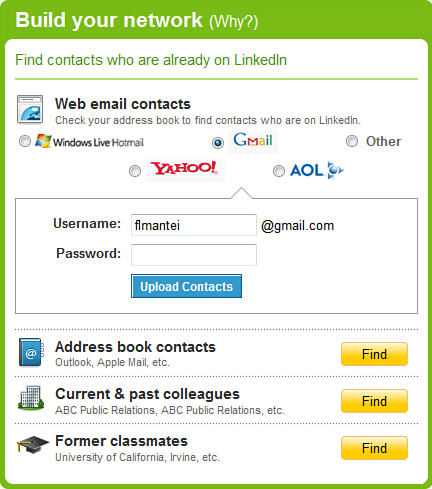
Note: Closing the Build Your Network Box
After you create a profile and develop a network of more than 20 connections, LinkedIn allows you to close the Build Your Network box by clicking the Close (x) button that appears in the upper-right corner.
For an alternate way to access these network-building tools, click the Add Connections button on the left navigation menu.
This box offers links to four easy ways to start developing your LinkedIn network. These include
• Importing your webmail contacts from services such as Gmail, Hotmail, AOL, or Yahoo! Mail
• Importing your address book contacts from Microsoft Outlook, ACT!, Palm devices, or Apple Mail
• Searching for current and former colleagues by company, job title, and years of employment
• Searching for current and former classmates by school and years of attendance
Keep in mind that you don’t need to use all these methods to develop your pool of LinkedIn connections. For example, you might not want to connect with all your webmail or address book contacts. Or your webmail account might contain personal email addresses, not the email addresses your contacts used to sign up for LinkedIn.
Note: Connect with Imported Contacts Manually
Importing your webmail or address book contacts doesn’t mean they automatically become LinkedIn connections. You must still manually choose whom to connect with.
If you have an email account with a popular webmail provider (such as Windows Live Hotmail, Gmail, Yahoo! Mail, or AOL), LinkedIn can import the email addresses of your web contacts.
To import webmail contacts, follow these steps:
- In the Build Your Network box, select your webmail provider from the available options. These include Windows Live Hotmail, Gmail, Yahoo! Mail, or AOL. If your provider isn’t one of these four, select the Other option button to display a list of alternative webmail providers, including many that are from outside the United States.
- Enter your User Name and Password.
- Click the Upload Contacts button. LinkedIn imports the contacts from your webmail contact list and displays these contacts in the Imported Contacts tab, shown in Figure 3.2.
- Select the check box to the left of each contact’s name you want to invite to connect on LinkedIn.
- Select the Add a Personal Note to Your Invitation check box to open a text box where you can personalize your connection request.
- Click the Invite Selected Contacts button to send your invitations.
Note: Confirm Your Email Address Before Connecting
You can’t send connection requests until you confirm your email address. If you need to request a new confirmation message from LinkedIn, click the Account & Setting link in the top navigation menu and then click the Email Addresses link. Select the email address you want to confirm and click the Send Confirmation Message button. LinkedIn sends you an email with confirmation instructions.
Your contacts will receive your connection requests and choose to accept or reject your request.
Although LinkedIn imports webmail contacts automatically, you need to export your contacts from other email systems as a separate step. To do so, follow the instructions your email system provides for exporting your email address book data to one of the following:
• A comma-separated values (CSV) file, which is a computer file in which fields are separated by commas with a .CSV filename extension
• A vCard file, which is a file format for electronic business cards with a .VCF filename extension
• A tab-separated file, which is a computer file in which fields are separated by tabs with a .TXT filename extension
LinkedIn accepts the following files for import:
• CSV files from Microsoft Outlook
• CSV or tab-separated files from Palm Desktop
• CSV files from ACT!
• vCard files from Palm Desktop
• vCard files from Mac OX X Address Book
To import a file exported from an email system, follow these steps:
- In the Build Your Network box, click the Find button in the Address Book Contacts section. The Add Connections page appears.
- Click the Browse button to select the appropriate file on your computer.
- Click the Upload Contacts File button. LinkedIn imports your file and asks you to verify the accuracy of the data you imported.
- If your data looks accurate, click the Finish Upload button.
LinkedIn returns to the Imported Contacts tab where you can send invitations to your new contacts.
To connect with current or past colleagues from the Build Your Network box, follow these steps:
- Click the Find button in the Current and Past Colleagues section. The Reconnect with Past Colleagues page appears, shown in Figure 3.3.
- Enter your Job Title, Company, and Years of employment for any past positions. LinkedIn will also search for the current position you entered when you signed up for your account.
- Click the Find Old Colleagues button. LinkedIn displays a list of colleagues who worked at the same companies at the same time as you.
- Select the individuals you know.
- Click the Send Invitations button to send connection requests to these people.
To connect with current or former classmates from the Build Your Network box, follow these steps:
By now, you should have a good start on developing your LinkedIn network. Here are a few other suggestions for finding worthwhile connections on LinkedIn:
• Review the list of people your connections are connected to, which displays in their profile. It’s very likely that you know some of the same people and would like to connect with them as well. View the profile of the person you want to connect with and click the Add [person’s name] to Your Network link to send an invitation from the Add Connections page. For example, to connect with Felice Mantei, you would click the Add Felice to Your Network link.
• Search for individuals by name in the Search People box on the top navigation menu. Click the Add to Network link to the right of the person you want to connect with to open the Add Connections page. For additional search options, click the Advanced link.
• Search by keyword and location on the Advanced Search page to find local members of your professional associations. Click the Advanced link on the top navigation menu to access this page. For example, you could search for the keyword PRSA (for the Public Relations Society of America) and the ZIP code 92606 within a 25-mile radius to find fellow PRSA members in Orange County, California.
• Search for potential connections among the members of any LinkedIn groups to which you belong. The Members tab provides a list of all group members and an Invite to Connect link with which to contact them. Remember, however, not to spam fellow group members with connection invitations. Be selective in determining who you want to connect with.
See Lesson 7, “Searching on LinkedIn,” for more information on searching for people.
When you click the Add to Network link from any of these options, the Add Connections page appears, shown in Figure 3.4.
To create a connection request on this page, follow these steps:
- Select how you know your target connection from these options:
• Colleague. Select a company from the drop-down list that appears.
• Classmate. Select a school from the drop-down list that appears.
• We’ve Done Business Together. Select a company from the drop-down list that appears.
• Friend.
• Groups & Associations. Select a group from the drop-down list that appears.
• Other. Enter the person’s email address.
• I Don’t Know [person’s name].
- Include a personal note in the text box explaining why you want to connect on LinkedIn. This is particularly important if you don’t know the person you want to connect with.
- Click the Send Invitation button to send your connection request.
See Lesson 6, “Communicating with Other LinkedIn Members,” for more information on viewing the status of connection invitations and other messages.
Tip: Consider Other Options for Contacting People You Don’t Know
Two other ways of connecting with people you don’t know are to send an InMail or request an introduction. See Lesson 6 for more information on InMail and introductions.
If you discover that some of your real-world networking contacts aren’t using LinkedIn yet, it’s easy to invite them:
- Click the Add Connections button at the bottom on the left navigation menu to open the Add Connections page, shown in Figure 3.5.
- Enter the First Name, Last Name, and Email address of each contact.
- Click the Edit/Preview Invitation Text link to open a text box where you can personalize the message to your contacts. This is particularly a good idea if your contacts may not be familiar with LinkedIn and the value it provides.
- Click the Send Invitation(s) button to send invitations.
In addition to sending invitations to connect, you might also receive invitations. To respond to an invitation, follow these steps:
- Click the Inbox link on the left navigation menu to open your Inbox.
- If you have several messages in your Inbox, select Invitations from the Received drop-down list. Your Inbox displays only your invitation requests. Alternatively, you can also view new invitation requests in your Inbox preview on your home page.
- To open the request, click the subject line link. Figure 3.6 illustrates a sample request to connect.
- View the greeting from the person who wants to connect with you.
- If you would like to open the individual’s profile, click the sender’s name. Reviewing a LinkedIn member’s profile can help you remember more about someone you don’t know well or decide whether to connect with someone you don’t know at all.
- Take one of the following actions:
• If you want to add the person to your network, click the Accept button.
• If you want to decline the invitation, click the I Don’t Know This User button. LinkedIn blocks this person from inviting you again, but you can send the person an invitation in the future if you decide to do so.
• If you don’t have time to review the invitation, click the Archive button to move the invitation to your Archived folder. You can accept or decline the invitation in the future.
• To send a message to the person who initiated the invitation before accepting or declining, click the Reply link. For example, you might want to ask why this person wants to connect before accepting.
• If you feel this invitation is spam, click the Flag as Spam link.
Caution: Think Carefully Before Flagging an Invitation as Spam
Be sure that an invitation truly is spam before flagging it. Flagging an invitation as spam is too harsh if it’s a genuine request from someone you just don’t want to connect with. Flagging as spam is appropriate, however, if the personalized greeting contains an overt sales pitch rather than a true connection invitation.
When you accept invitations, LinkedIn adds those members as 1st degree connections in your network. If you would like to add notes about the person and edit their contact information, use the Your Private Information About [First Name] box on their profile.
Once you develop your LinkedIn network, you need an easy way to find and manage your existing connections. The Connections page offers several ways to do this.
Click the Connections link on the expanded left navigation menu to open the Connections page, which displays a list of your connections (see Figure 3.7).
If you have many connections, it may be difficult to find the person you’re looking for. LinkedIn offers several ways to filter your connections. You can
• Click the first letter of a contact’s last name to display only those contacts whose names start with that letter. If you don’t have any contacts for a specific letter, that letter’s link isn’t displayed.
• Select the Show Contacts with New Connections check box. Doing this lets you know which of your contacts recently connected with someone new on LinkedIn. Perhaps you know this person and would like to connect as well?
• Click the Advanced Options button to filter by Location or Industry.
The View & Edit Details link beneath each connection’s name opens a window where you can enter more detailed information about this connection, such as a phone number or website URL. To view a connection’s profile, click on that individual’s name.
If you decide that you no longer want to connect with someone on LinkedIn, you can remove that person as a connection:
- Click the Connections link in the expanded left navigation menu to open the Connections page.
- Click the Remove Connections link in the upper-right corner of the page.
- Select the check box next to the connections you want to remove.
- Click the Remove Connections button.
People you remove are no longer able to view any data that can be viewed only by actual connections and they also can’t send you direct messages. LinkedIn, however, doesn’t notify them of the fact they have been removed.
Caution: Remove Connections for the Right Reason
Be sure that a connection really warrants removal before proceeding with the removal process. For example, if a connection you don’t know well is bothering you with requests, spam, or sales pitches, this person is probably a connection worth removing. Removing former colleagues or associates simply because you haven’t seen them in a while or don’t work with them anymore, however, can be shortsighted.
The Network Statistics page provides some interesting statistics about your network, including your total number of connections, the number of members you can reach through an introduction, the number of new people in your network, and much more. To view these stats, click the Network Statistics link in the expanded left navigation menu.

